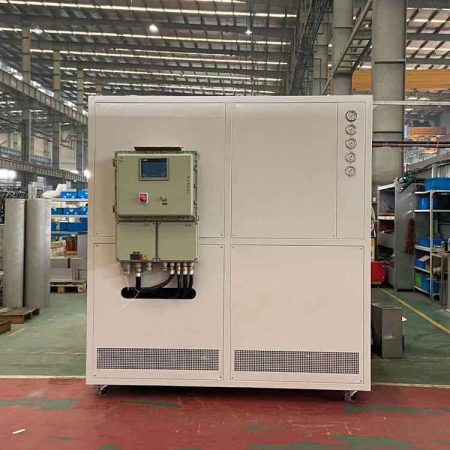Water Refrigeration System
完璧な温度制御ソリューションについては、今すぐお問い合わせください。
A water refrigeration system is a device that can dissipate heat from computers or electronic equipment. It is a system composed of water cooling plates, water pipes and water pumps, usually combined with coolers and radiators to achieve cooling of the system.
The water refrigeration system is characterized by a certain ultra-quiet effect. Compared with air-cooled heat dissipation, blast heat dissipation may cause the system to be noisier, while water cooling can solve this problem. It is quieter and can effectively reduce noise. In addition, water cooling effectively reduces the temperature of the space to be cooled and greatly improves heat dissipation performance.
Nowadays, water refrigeration systems are widely used and can be widely used in computer internal components such as microprocessors, motherboards, and graphics cards, as well as in the cooling of robots, instrumentation, solar cell components, automobile engines, and robots.

1. Definition and classification of water refrigeration system
Water refrigeration system is a technology that uses water coolers to reduce heat transfer temperatures. This technology can transfer a large amount of heat from the heat source to the water cooler, allowing the equipment to operate more stably. From the perspective of its application occasions and working principles, water refrigeration systems can be divided into two categories: one is large-scale systems such as air conditioning systems, refrigeration systems, and refrigeration systems, which are mainly used in fields such as construction, industry, and agriculture; the other The category refers to small systems such as electronic cooling systems and computer heat dissipation systems, which are mainly used in fields such as electronic equipment and computers.
2. Main components of water refrigeration system
The main components of the water refrigeration system include: radiators, water pumps, water tanks, water pipes, heat sinks and controllers, etc., and these components need to be interconnected through communication pipes. The radiator is one of the most critical components in a water cooling system, responsible for separating the heat generated by microprocessors such as CPUs from the surrounding environment. The water pump is the engine in the water cooling system that circulates water. The water tank is the place where water is stored in the water refrigeration system. It can be designed into a large or small water tank according to needs. Water pipes are the water lines that connect components such as water tanks and radiators. The heat sink is the part in contact with the microprocessor, and its surface can be made of specific materials to improve the heat dissipation efficiency of the microprocessor. The controller is the brain of the entire water refrigeration system. It can customize and adjust fans, water pumps and other equipment as needed.
3. Application fields of water refrigeration system
Water refrigeration system is an efficient and stable cooling method, which is widely used in computer cooling, electronic product cooling, automobile engine cooling and other fields. In the computer field, water cooling systems can effectively solve the heat dissipation problems of important components such as CPUs and graphics cards, making the computer system run more stable and faster. In the automotive field, water refrigeration system is an important part of the automotive cooling system, which can effectively reduce the temperature of the engine during operation, thereby ensuring the long-term stable operation of the automotive system.
In short, the water refrigeration system is an efficient temperature control method that achieves temperature control through the cooperation of components such as radiators, water pumps, water tanks, water pipes, heat sinks, and controllers. This technology has broad application prospects in computers, automobiles, electronic products and other fields.
Eメール info@lneya.com WeChat ID: +8615251628237 WhatsApp: +86 17851209193
 精密冷凍機/小型冷凍機
精密冷凍機/小型冷凍機
(カスタムデザイン)
チラーは様々な産業や研究所で広く使用することができ、カスタマイズされた設計をサポートしています。
| 温度範囲 | -18°C ~ +30°C | +5°C ~ +35°Cシリーズ |
| 冷却能力 | 0.35 ~ 0.9kW | 1.8~50kW |

循環式チラー
(カスタムデザイン)
私達の再循環のスリラーは低温冷凍の技術を採用し、温度は- 120℃と低く、さまざまな付属品はカスタマイズ可能です。
| 温度範囲 | -25°C ~ +30°Cシリーズ | -45°C ~ +30°Cシリーズ | -60°C ~ -20°Cシリーズ | -80°C ~ -20°Cシリーズ | -120°C ~ -70°Cシリーズ |
| 冷却能力 | 0.8 ~ 30kW | 0.75 ~ 12kW | 0.4 ~ 6kW | 0.2 ~ 6kW | 0.3 ~ 5kW |

低温チラー
(カスタムデザイン)
当社は、-150℃の温度制御範囲を持つ低温冷凍機の生産を専門としており、さまざまな業界の冷凍ニーズを満たすことができます。
| 温度範囲 | -25°C ~ -5°Cシリーズ | -45°C ~ -10°Cシリーズ | -60°C ~ -10°Cシリーズ | -80°C ~ -30°Cシリーズ | -110°C ~ -50°Cシリーズ | -150℃〜-110℃シリーズ |
| 冷却能力 | 12~360kW | 6~180kW | 6~180kW | 4〜180kW | 2~120kW | 2.5 ~ 11kW |
(カスタムデザイン)
車両品質テスト用温度シミュレーション:バッテリー寿命テスト、燃料噴射装置/モーターテストベンチ、エアバッグテスト、コンポーネントテストベンチなど。

(カスタムデザイン)
電子部品の精密な温度制御に適しています。過酷な環境に対応する半導体電子部品の製造では、ICパッケージの組み立てやエンジニアリング、製造テストの段階で、電子温度テストやその他の環境テストシミュレーションが行われます。

バッテリーエネルギー貯蔵システム用液体冷却
(カスタムデザイン)
| 種類 | コンバーティング・ステーション用 | 蓄電池用 | 充電ステーション用 |
| 冷却能力 | 45kW | 5 ~ 8.5kW | 4kW |

ZLFQシリーズ
(カスタムデザイン)
クーラント分配ユニット
液冷装置は、半導体試験、電子機器恒温試験、サーバー支持インフラ冷却、その他の流体温度制御場所に適しています。
| 温度範囲 | +5°C ~ +35°C | +5°C ~ +35°C |
| 冷却能力 | 15~150kW | 200~500kW |

MDサーマルチャックシリーズ
(カスタムデザイン)
RFデバイスや高密度パワーデバイス(IGBTやMOSFET)のテストに使用され、実験用フラットパネル(プラズマ、生物学的製品、バッテリー)などの急速冷却にも使用できる。
| 温度範囲 | -75°C ~ +225°C |
| 温度精度 | ±0.1℃ |

スクリュー冷凍機 (カスタムデザイン)
低温スクリュー冷凍機と常温スクリュー冷凍機
| 温度範囲 | +5°C ~ +30°C | +5°C ~ +30°C | +5°C ~ +30°C | +5°C ~ +30°C | -25°C ~ +5°C | -25°C ~ +5°C |
| 冷却能力 | 107~1027kW(シングルコンプレッサー) | 299~2134kW(デュアルコンプレッサー) | 98~934kW(シングルコンプレッサー) | 272~1940kW(デュアルコンプレッサー) | 48~467kW(シングルコンプレッサー) | 51~497kW(シングルコンプレッサー) |
 LNEYA
LNEYA
 简体中文
简体中文



















































































